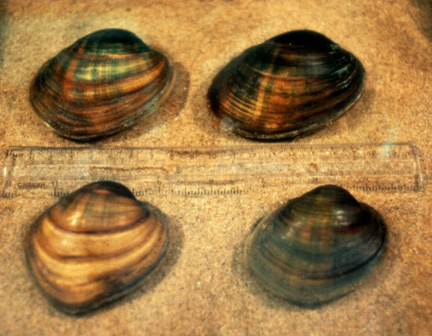Note: This page is a reproduction of a page from the U.S. Fish and Wildlife Service.
"Endangered Species Facts: Higgins' Eye Pearlymussel." U. S. Fish and Wildlife Service: Region 3. 16 February 2003
<http://midwest.fws.gov/endangered/clams/higginseye/higgins_fs.html>.
Endangered
Species Facts
(pdf
version)
Higgins' Eye Pearlymussel
The Higgins' eye pearlymussel is an endangered species. Endangered species are animals and plants that are in danger of becoming extinct. Threatened species are animals and plants that are likely to become endangered in the foreseeable future. Identifying, protecting, and restoring endangered and threatened species is the primary objective of the U.S. Fish and Wildlife Service's endangered species program.
What is the Higgins' eye pearlymussel?
Scientific Name - Lampsilis higginsi
Appearance - Higgins' eye pearlymussel is a freshwater mussel with a rounded to slightly elongate smooth-textured shell that is usually yellowish brown with green rays. The shell, made up of 2 hinged, inflated halves, is up to 4 inches in length and has a rounded side and a pointed (males) or squared (females) side. The inside of the shell is white with portions that are iridescent and areas that may be tinged with cream or salmon. The soft body enclosed by the shell consists of gills for breathing, a digestive tract for processing food, and a large muscled foot for moving the animal.
Range - Higgins' eye pearlymussels are now found in parts of the following rivers: the upper Mississippi River north of Canton, Missouri, and in 3 tributaries of the Mississippi River - the St. Croix River between Minnesota and Wisconsin, the Wisconsin River in Wisconsin, and the lower Rock River between Illinois and Iowa. The species' current range is about 50% of its historic distribution. Even within its current range it formerly was more widespread and abundant, occurring as far south as St. Louis, Missouri, and in several additional tributaries of the Mississippi River.
Habitat - The Higgins' eye is a freshwater mussel of larger rivers where it is usually found in areas with deep water and fast currents. The animals bury themselves in the sand and gravel river bottoms with just the edge of their partially-opened shells exposed. The river's currents flow over the mussels as they siphon water for microorganisms such as algae and bacteria, which they use as food. The role of Higgins' eye pearlymussels in the natural river ecosystems is as a food source for wildlife like muskrats, otters, and raccoons and as a filter which improves water quality.
Reproduction - The male Higgins’ eye releases sperm into the river current and downstream females siphon in the sperm to fertilize their eggs. After fertilization, the females store the developing larvae (glochidia) in their gills until they’re expelled into the river current. Some of the glochidia are able to attach themselves to the gills of host fish, where they develop further. After a few weeks, the juvenile mussels detach from the gills of the fish and settle on the river bottom, where they can mature into adult mussels and possibly live up to 50 years. The sauger, walleye, yellow perch, largemouth and smallmouth bass, and freshwater drum are considered suitable hosts for Higgins’ eye glochidia.
Why is the Higgins' eye pearlymussel endangered?
Habitat Loss or Degradation - Higgins’ eye pearlymussels depend on deep, free-flowing rivers with clean water. Much of their historic habitat was changed from free-flowing river systems to impounded river systems. This resulted in different water flow patterns, substrate characteristics, and host fish habitat and movement which affect how the Higgins’ eye feed, live, and reproduce. Municipal, industrial, and farm run-off degrade water quality. As a filter-feeder, this species concentrates chemicals and toxic metals in body tissues and can be poisoned by such chemicals in the water. Dredging and waterway traffic produce siltation which cover the substrate and mussel beds.
Exotic Species - The zebra mussel is a freshwater mussel native to the Black and Caspian Seas that was introduced into Lake Erie in the late 1980’s from ship ballast water discharge. This small mussel is less than 2 inches in length, but tens of thousands can colonize a square meter area. They attach to any hard surface, including shells of other mussels. They compete for food with native species and, when attached to the shells, prevent normal travel, burrowing, and opening and closing of the shells.
What is being done to prevent extinction of the Higgins' eye pearlymussel?
Listing - The Higgins’ eye pearlymussel was added to the U.S. List of Endangered and Threatened Wildlife and Plants in 1976. As a result of the listing, the U.S. Fish and Wildlife Service developed a recovery plan that describes actions needed to help this species survive.
Research - Researchers are continuing studies of zebra mussels and their impacts on Higgins’ eye, of commercial navigation impacts on mussels, and of water quality and contaminant relationships to the species.
Habitat Protection - A variety of government and private conservation agencies are working to preserve Higgins’ eye pearlymussel and its habitat.
What Can I Do to Help Prevent the Extinction of Species?
Learn - Learn more about Higgins’ eye pearlymussel and other endangered and threatened species. Understand how the degradation and destruction of endangered and threatened species and our nation’s plant and animal diversity. Tell others about what you have learned.
Join - Join a conservation group; many have local chapters.
Protect - Protect water quality by minimizing use of lawn chemicals (i.e., fertilizers, herbicides, and insecticides), recycling used car oil, and properly disposing of paint and other toxic household products.
Follow - When boating, please follow any rules established to prevent the spread of exotic pests like the zebra mussel.
May 2001
E-Mail Us!
Phone: 612/713-5360
V/TTY: 800-657-3775Region 3 Endangered Species Home Page
National Endangered Species Home Page
Region 3 Home Page USFWS Home PageU.S. Fish and Wildlife Service
Division of Endangered Species
BHW Federal Building
1 Federal Drive
Fort Snelling, Minnesota 55111-4056


 /
/